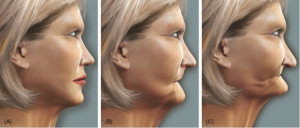Teeth and Aging

Vertical dimension of occlusion, VDO, is defined as the relationship between the maxillary (top) and mandibular (bottom) teeth in a closed mouth. Loss of VDO can result in premature aging of the face as the bite becomes collapsed.
What Causes Loss of VDO?
There are several causes of loss of vertical dimension of occlusion. The most common is grinding. When we grind, the portion of the tooth that sits above your gums, known as the crown, is worn down. This leads to decreased distance between maxillary and mandibular teeth, or VDO (see images).
Another common cause is loss of posterior teeth. Posterior teeth, or molars, are able to withstand everyday chewing and biting forces. When enough posterior teeth are lost due to severe decay, anterior teeth and supporting bone are not able to maintain normal biting forces and they begin to tilt. This domino effect leads to loss of VDO.

In addition to loss of tooth structure, loss of supporting (alveolar) bone will lead to loss of VDO. Alveolar bone is what holds teeth firmly in their socket. Aging, gum disease, and periodontal disease can all lead to damage and subsequent loss of alveolar bone. Like any other bone in our body, alveolar bone is maintained by use. If we are not using the bone by placing chewing forces on it, then it will weaken and shrink. Bones need to have stresses placed on them frequently in order to be strong. Dentures are not integrated into alveolar bone, thus they do not place stress on the bone, and in time the alveolar bone will loss dimension. This is a strong indicator for implants in patients who are candidates for them. Since implants mimic roots of teeth, using them will maintain the integrity of alveolar bone and avoid the detrimental effects of bone loss.
How Do I Know If I Have Bone Loss?
Patients with loss of VDO will often complain that they are suddenly biting their cheek more often. They may also notice a drooping smile, appearance of thinner lips, or sunken cheek.
What Should I Do?
Talk to your dentist if you feel you may have some symptoms of bone loss. Depending on the precise causes there could be several treatment options for you.
References
“Change your Smile,Change Your LifeWith Advanced Dentistry.” Full Mouth Reconstruction PGA Dentistry, www.pgadentistry.com/dental/full-mouth-reconstruction.html.
Ladda, Ruchi, et al. Journal of Clinical and Experimental Dentistry, Medicina Oral S.L., Oct. 2014, www.ncbi.nlm.nih.gov/pmc/articles/PMC4282908/.
“Loss of Vertical Dimension of Occlusion / Bite Collapse.” ToothIQ, www.toothiq.com/dental-diagnosis/loss-of-vertical-dimension-of-occlusion/.
Mengatto, Cristiane Machado, et al. Clinical, Cosmetic and Investigational Dentistry, Dove Medical Press, 2016, www.ncbi.nlm.nih.gov/pmc/articles/PMC4853149/.
Shah, Farhan Khalid, et al. The Journal of Advanced Prosthodontics, The Korean Academy of Prosthodontics, May 2012, www.ncbi.nlm.nih.gov/pmc/articles/PMC3381204/.
Sierpinska, Teresa, et al. The Open Dentistry Journal, Bentham Open, 2013, www.ncbi.nlm.nih.gov/pmc/articles/PMC3681002/.

